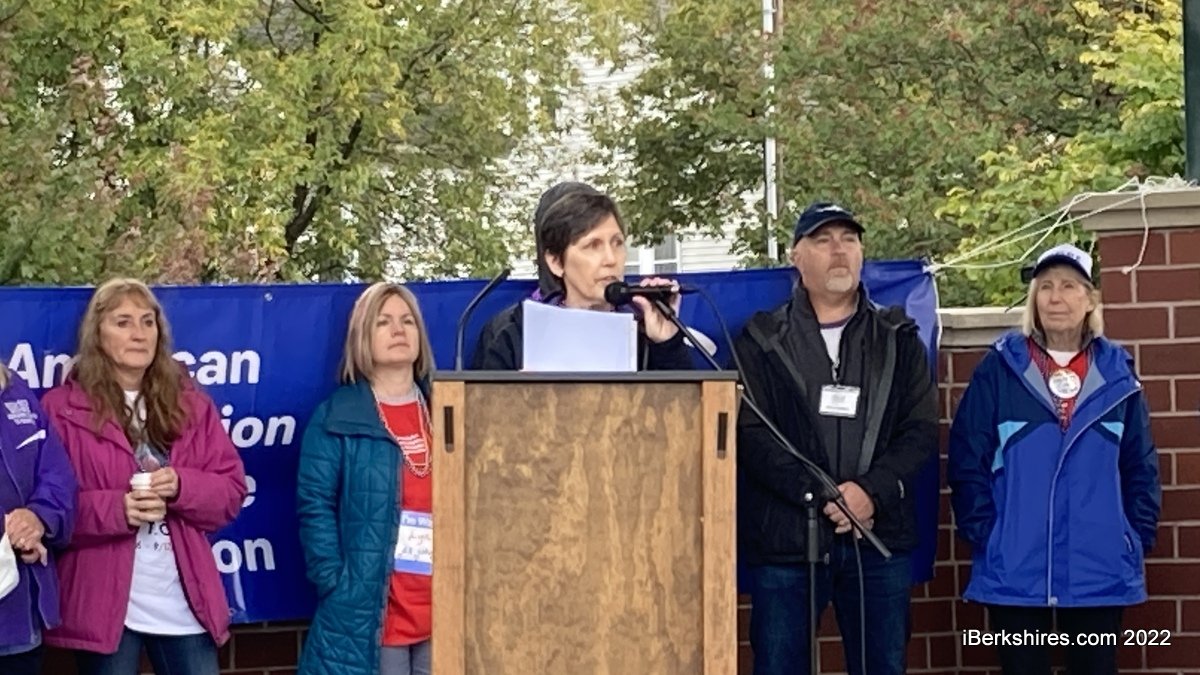



Community Walks 'Out of The Darkness' for Suicide Prevention

PITTSFIELD, Mass. — Some 200 people participated in the Berkshire County Out of the Darkness walk for suicide prevention on Saturday. For some, it was a day to honor the life of a loved one and for others, it was a day to acknowledge themselves as survivors.
Walkers began at the Common, made a loop around Silver Lake, and returned back to the park. The walks began nationally in 2004 and has been in the Berkshires since 2015.
Members of the Berkshire Coalition for Suicide Prevention and others shared their stories during the event of how suicide affected them and their families.
The National Suicide Prevention Lifeline is 1-800-273-8255. To contact the Crisis Text Line, text HELLO to 741741.
"We're all here because we have a connection to suicide," said coalition Vice President Bertha Connelley. "We acknowledge all the different connections that bring you here today."
According to data from American Federation for Suicide Prevention, around 46,000 people died by suicide in the United States in 2020. That is 125 per day and one every 11 1/2 minutes.
"We also know that 90 percent of these people had a diagnosable and treatable psychological illness at the time of their death," Connelley added.
"We've gathered here today to raise awareness, decrease the stigma, and support research that will help identify and treat people suffering from mental illnesses with the ultimate goal of continuing to lower these numbers ...
"So these are statistics, but behind every statistic, there's a real human being, someone that is loved beyond death, and who during their lifetime had many hopes and dreams."
She stood at the event for her brother, father, and son.
"All good men who suffered from depression. Whatever their demons were, over the years, the pain became too great to bear. These deaths were years ago, but they still hold more questions than answers for me. But those deaths fueled my passion for suicide prevention," Connelley explained.
"I stand here today for my whole family impacted by loss. I stand here because I don't want another parent, sibling, child, or friend to learn from a phone call that someone that they love has died by suicide. I don't want anyone to feel shame for having mental illness. It's not a choice and often it is treatable. We know that removing the stigma opens the doors to treatment as well as prevention."
She said stigma surrounding a death can also affect how well people adjust after loss and how community support can help them adapt, cope, and even grow through it.
"I look out at this crowd and I don't see a bunch of numbers. I see a gathering of courageous individuals who are willing to work together in the name of love to bring about change," Connelley concluded.
Coalition board member and recently retired Pittsfield teacher Lori Murphy shared her connections to the cause. Murphy is a survivor who also lost her brother to suicide.
She said her story has five short chapters.
"My journey out of the darkness began in 2007. It was my first year teaching psychology to high school students. While I relished creating lesson plans about the brain and other topics, I began to struggle with how to teach the unit on mental illness. I had a choice to make: deliver the lessons from a textbook perspective, or be real with my students and share my personal journey," Murphy explained.
"I chose the latter, although I was plagued with doubts and anxiety. Quite terrified, the first time I spoke about my experience with severe clinical depression, hospitalization, and the long road to recovery, when I finished the lesson one of the students spoke up 'But Miss Murphy, you seem so normal,’ and that was the point. To allow my students to see that mental illness, as with other illnesses, could in many cases be diagnosed and treated and a person could recover and flourish."
She taught the lesson plan for the next dozen years while omitting her own suicide attempt that led to her hospitalization, a fact only shared with close family and friends.
The second and third chapters of Murphy's story are about her brother Dan, who took his life in 2009.
In late 2008, she was notified that her brother was greatly suffering from anxiety and sadness. For the next six months, she called him every night at 7 p.m. to check in and talk.
"For the first time in our lives. Dan talked to me about his struggles and his emotions. While we had always been close, like many men, he was never one to go down those roads. It was terribly difficult for him to ask for help. He did not want to appear weak or vulnerable," Murphy said.
"Dan was also suffering terribly every moment of every day, as he put it so well 'I just can't find my way back to myself.' While he did seek treatment, nothing worked and he refused to be hospitalized. Each day he put on what he and I would call 'the face' and gutted through work and life."
Dan drove away on May 20 and did not return. This forever altered the family and began chapter four of Murphy's story.
"The early stages of grief over the loss of my beloved brother were debilitating. My own three children, my sister, my students, and my closest friends were amazingly supportive. They were direct and loving. Many people, some I barely knew, shared stories of the suicides of their loved ones and invited me for dinner or walks. I am eternally grateful to all of them," she explained.
"I struggled the most when people purposefully avoided me or the subject of Dan's death. I went back to therapy and immediately found the local suicide support group which I still attend. I hiked alone in the woods with grief as my constant companion but slowly began to let go of guilt and what ifs. Neither was going to bring Dan back or keep me from sliding downhill. I also knew that what Dan had wanted the most in those last six months was to be able to laugh again and to feel joy, and I knew he would want that for me as well. So I just kept moving forward one step at a time."
The last chapter of this story of where fully Murphy came out of the darkness in 2011, attending her first overnight walk in New York City.
Murphy said it was overwhelming and comforting to see tens of thousands of people walking in memory of loved ones lost to suicide and for the first time, she was able to let others know that she was a survivor of and lost someone to suicide by wearing the colored beads.
"I do not stay silent anymore if I know that sharing my story will help someone. We know from research that talk saves lives and silence can be deadly. A wise man from our support group recently noted that while none of us signed up to be in this club, our loss can make us more compassionate and empathetic. We are connected to each other through our grief," she concluded. "I am still moving through the trauma of loss toward finding peace. I know that I am not alone. Please know that you are not alone."
Nine different colors of beads were available at the event to allow participants to indicate how they have been touched by suicide — loss of a child, spouse or partner, parent, sibling, friend, person in the military or first responder, or personal struggle or attempt, as well as for supporting someone who struggles and for prevention.
"It's not something that I like to talk about. It's not something that that's easy to talk about," survivor Paul Johansen said. "And I've been thinking about trying to turn that into something positive and I guess today's the day."
After a fellow patient died of suicide in the mental health facility that Johansen was in, he became convinced that it was not a good option. Though he did not know her well, there was shared devastation among the patients at the facility and it was difficult for him to imagine what her family was going through.
In 2015, Johansen went through that grief process when his cousin died of suicide at the age of 55.
"This is my seventh walk. It's nice to see that it gets bigger and bigger every year, even on cold rainy days," he said. "I think that speaks to reducing stigma and I think that's the only way to face this problem."
The fundraising goal for the walk was $80,000. The top fundraising teams were the Stockbridge Stompers, Team Tommy, BCSP, Annie's Angels, and Dylan's Eagles.
For resources and to find more walks, visit the American Federation for Suicide Prevention's website.
The National Suicide Prevention Lifeline is 1-800-273-8255. To contact the Crisis Text Line, text HELLO to 741741. More information on crisis hotlines in Massachusetts can be found here.
Tags: suicide,















